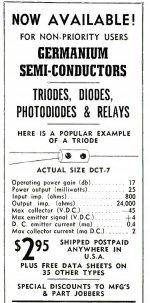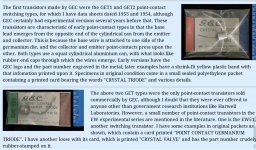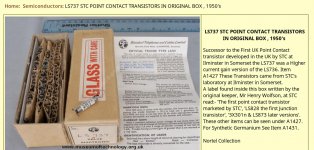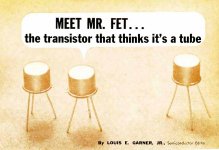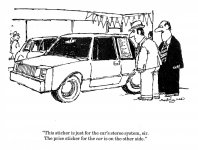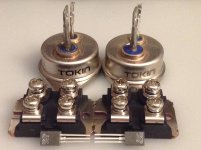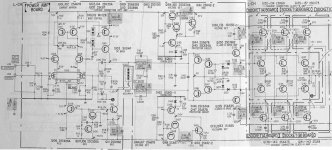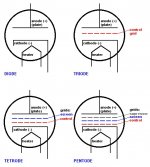I can't resist....
I own this photo of the first transistor, autographed by the inventors.
(one of the signatures has faded with the years - cheap ball point pen!)
Thanks Mr Pass for interesting show.
Beautiful collection legendary piece in right hands 😀
The first generation of transistors was revolutionary tech plenty of "mysteries" and not many photos of curve tracer tests.
Something to do with rare museum "crystals" 🙂
Attachments
1pc THF-51S TOKIN V-FET(SIT) (similar 2SK77,2SK180) NOS Original, Japan Made | eBay
Bunch of Obtainium Unobtainum's
Bunch of Obtainium Unobtainum's
Attachments

On the video made by Linear Integrated Systems at Burning Amp Festival
Mr Pass speak about this Tokin 400 W | 500 W triode transistors Japan seller source.
Sequence start 1:07:37
Papa talk BAF 2017
Attachments
Flakey Foont: "Mr. Natural! What does it all mean?"
Mr. Natural: "Don't mean SIT"
(Just couldn't resist)
Mr. Natural: "Don't mean SIT"
(Just couldn't resist)
I bought my 180's from that guy. Very good. They work great on my single ended common source amp with a "cascoded-compound CFP" differential amplifier on the input.
I asked for matched pairs for the 51's but still no answer... I bought a monster heatsink for them 😀
Dear Mr. Pass,
IF/when I will cascode the output common-source SIT (with BJT or Mosfet), will the cascodying common-base element be "slaved" to follow the SIT transfer characteristics???
Many thanks,
M.
I asked for matched pairs for the 51's but still no answer... I bought a monster heatsink for them 😀
Dear Mr. Pass,
IF/when I will cascode the output common-source SIT (with BJT or Mosfet), will the cascodying common-base element be "slaved" to follow the SIT transfer characteristics???
Many thanks,
M.
@ Maxlorenz
Congrats for Your differential CFP experimentation !
From memory this Papa video talk was highly instructive about :
High power transistors | start at 12:00
Cascode of hockey puck | start at 18:35
Mr Pass at BAF 2016 part 2
Huge mosfet and SIT can have similar parameters for example : Ciss
but are totaly different on the other side : pentode versus triode etc.
Interesting semi's anyway
Have fun
Congrats for Your differential CFP experimentation !
From memory this Papa video talk was highly instructive about :
High power transistors | start at 12:00
Cascode of hockey puck | start at 18:35
Mr Pass at BAF 2016 part 2
Huge mosfet and SIT can have similar parameters for example : Ciss
but are totaly different on the other side : pentode versus triode etc.
Interesting semi's anyway
Have fun

IF/when I will cascode the output common-source SIT (with BJT or Mosfet), will the cascodying common-base element be "slaved" to follow the SIT transfer characteristics?
Interesting question.
Cascoding doesn't necessarily imply constant voltage across the gain
device, rather it is control of that voltage.
If you hold constant voltage across a SIT you put it in the position of
behaving more like a Pentode, with little or no influence of the Drain
impedance on the performance. Usually the interesting part of the SIT
is just that, it's Triode character allowing the Drain to Source voltage to
be part of the equation.
I think it is useful to imagine allowing a portion of the output voltage
to appear on the Drain, often for the purpose of cancelling the
variation of gain due to change of current, and a cascode is a good
way to do that. The percentage of output AC appearing via the
cascode on the Drain can be matched against the load impedance to
find a "sweet spot".
Many thanks to ZM, SH and NP for your replies. 🙂
I am trying to figure out if there's a way to control the behavior of (a group of) transistors from one SIT... 😎 There's and article that talks about it but it is too heavy to upload.
9. Static Induction Devices - POWER ELECTRONICS HANDBOOK, 3rd Edition [book=]%[/book][book=
The big SITs have big input capacitances, right? And that must influence its sound. The 182 having the biggest and the TH51S having the lowest, from memory...so it would be interesting to evaluate cascoding of the output and its influence in sound. 😉
From my part, I have yet to find a circuit in which cascoding (or vertically cascading) the outputs have not produced a significant improvement in perceived sound and musical satisfaction, even implemented as badly as my limited skills allow...I recently implemented a cascoded-CFP output that narrowed the quality gap between BJT and SIT outputs! 😎
Dear Mr Pass, I will digest your reply and try to figure out how to find the sweet spot.
Cheers,
M.]%[/book]
I am trying to figure out if there's a way to control the behavior of (a group of) transistors from one SIT... 😎 There's and article that talks about it but it is too heavy to upload.
9. Static Induction Devices - POWER ELECTRONICS HANDBOOK, 3rd Edition [book=]%[/book][book=
The big SITs have big input capacitances, right? And that must influence its sound. The 182 having the biggest and the TH51S having the lowest, from memory...so it would be interesting to evaluate cascoding of the output and its influence in sound. 😉
From my part, I have yet to find a circuit in which cascoding (or vertically cascading) the outputs have not produced a significant improvement in perceived sound and musical satisfaction, even implemented as badly as my limited skills allow...I recently implemented a cascoded-CFP output that narrowed the quality gap between BJT and SIT outputs! 😎
Dear Mr Pass, I will digest your reply and try to figure out how to find the sweet spot.
Cheers,
M.]%[/book]
Another thought:
What if we arrange things all the way round, with say a lateral MOSFET (as SK1058) as the common-source and a SIT as common-gate cascoding element, doing the voltage swing...will it retain its triode curve or will it be slaved by the MOSFET action???
Anyway, effects of both Cg-d would be negligible, right?
Thanks for your patience. 😀
M.
What if we arrange things all the way round, with say a lateral MOSFET (as SK1058) as the common-source and a SIT as common-gate cascoding element, doing the voltage swing...will it retain its triode curve or will it be slaved by the MOSFET action???
Anyway, effects of both Cg-d would be negligible, right?
Thanks for your patience. 😀
M.
In one of the last iterations of VFET amps, Sony used the VFETs as
cascodes for bipolars.
Myself, I think they are too precious for that.
cascodes for bipolars.
Myself, I think they are too precious for that.
Perfect example of one complicated vintage amp circuit from the past.
Let's look at the future now 😀
What cool Tokin spec they have lot of transductance.
Single transistor can do 20 dB of gain I guess and bunch of amplification watts too.
Integrated SIT version with jfet impedance buffer and passive volume stepped attenuator , LDR, AVC etc.
that can be one audio nirvana solution with adequate hi quality source and speakers imho. What You think ?
Let's look at the future now 😀
What cool Tokin spec they have lot of transductance.
Single transistor can do 20 dB of gain I guess and bunch of amplification watts too.
Integrated SIT version with jfet impedance buffer and passive volume stepped attenuator , LDR, AVC etc.
that can be one audio nirvana solution with adequate hi quality source and speakers imho. What You think ?
An externally hosted image should be here but it was not working when we last tested it.
In one of the last iterations of VFET amps, Sony used the VFETs as
cascodes for bipolars.
Myself, I think they are too precious for that.
That did seem odd...almost as if they just want to use up the supply of parts... 🙁
Perfect example of one complicated vintage amp circuit from the past.
Let's look at the future now 😀
What cool Tokin spec they have lot of transductance.
Single transistor can do 20 dB of gain I guess and bunch of amplification watts too.
Integrated SIT version with jfet impedance buffer and passive volume stepped attenuator , LDR, AVC etc.
that can be one audio nirvana solution with adequate hi quality source and speakers imho. What You think ?
Yes, but we have to seek for the best sound possible and I do worry about Miller effect, you know...I´m like this...cannot help it. 🙁
My single ended Mosfet amp (ZCA) improved a lot when I cascoded it, soundwise.
I now strive for increased transparency, increased inteligibility and dinamics, traits that frankly could be better on the single ended amps, even VFETs...
The ideal solution for me would be one puck VFET cascoded by a high Vgs-off VFET...I wish I had some for experimenting 🙁 Wait! I do have some for experimenting! 😀 😎
That did seem odd...almost as if they just want to use up the supply of parts...
Maybe they thought it sounded better this way... ;-)
Last edited:
The ideal solution for me would be one puck VFET cascoded by a high Vgs-off VFET...I wish I had some for experimenting 🙁
Wait! I do have some for experimenting! 😀 😎
Maybe they thought it sounded better this way... ;-)
Interesting Vfet cascoded by vfet what be happen ?
Behaving like a tetrode

Attachments
- Home
- Amplifiers
- Pass Labs
- Hockey Puck SIT 2SK180 by Tokin source NOS

